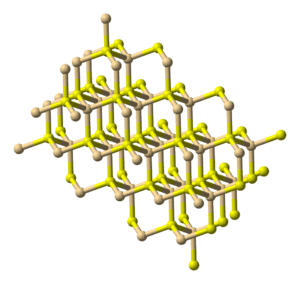Hawleyite
From Wikipedia, the free encyclopedia
| Hawleyite | |
|---|---|
 Orange-yellow earthy coating | |
| General | |
| Category | Sulfide mineral |
| Formula (repeating unit) | CdS |
| Strunz classification | 02.CB.05a |
| Crystal symmetry | Isometric 4 3m |
| Unit cell | a = 5.818 Å; Z = 4 |
| Identification | |
| Color | Bright yellow |
| Crystal habit | Powdery massive |
| Crystal system | Cubic-hextetrahedral |
| Mohs scale hardness | 2.5-3 |
| Luster | Metallic |
| Streak | Light yellow |
| Diaphaneity | Translucent to opaque |
| Specific gravity | 4.87 |
| References | [1][2][3] |

Structure of Hawleyite
Hawleyite is a rare sulfide mineral in the sphalerite group, dimorphous and easily confused with greenockite. Chemically, it is a cadmium sulfide, and occurs as a bright yellow coating on sphalerite or siderite in vugs, deposited by meteoric waters.[3]
It was discovered in 1955 in the Hector-Calumet mine, Keno-Galena Hill area, Yukon Territory and named in honour of mineralogist James Edwin Hawley (1897–1965), a professor at Queen's University in Ontario, Canada.[2][1]
See also
References
This article is issued from Wikipedia. The text is available under the Creative Commons Attribution/Share Alike; additional terms may apply for the media files.